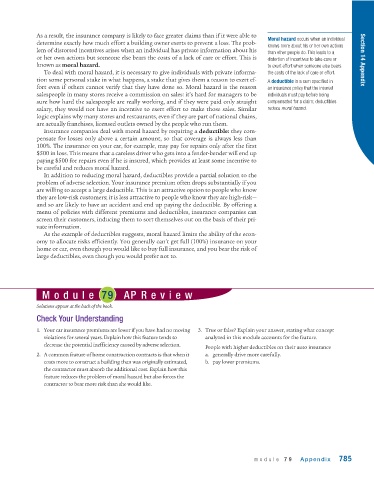Page 827 - Krugmans Economics for AP Text Book_Neat
P. 827
As a result, the insurance company is likely to face greater claims than if it were able to
Moral hazard occurs when an individual
determine exactly how much effort a building owner exerts to prevent a loss. The prob-
knows more about his or her own actions
lem of distorted incentives arises when an individual has private information about his than other people do. This leads to a
or her own actions but someone else bears the costs of a lack of care or effort. This is distortion of incentives to take care or Section 14 Appendix
known as moral hazard. to exert effort when someone else bears
To deal with moral hazard, it is necessary to give individuals with private informa- the costs of the lack of care or effort.
tion some personal stake in what happens, a stake that gives them a reason to exert ef- A deductible is a sum specified in
fort even if others cannot verify that they have done so. Moral hazard is the reason an insurance policy that the insured
salespeople in many stores receive a commission on sales: it’s hard for managers to be individuals must pay before being
sure how hard the salespeople are really working, and if they were paid only straight compensated for a claim; deductibles
salary, they would not have an incentive to exert effort to make those sales. Similar reduce moral hazard.
logic explains why many stores and restaurants, even if they are part of national chains,
are actually franchises, licensed outlets owned by the people who run them.
Insurance companies deal with moral hazard by requiring a deductible: they com-
pensate for losses only above a certain amount, so that coverage is always less than
100%. The insurance on your car, for example, may pay for repairs only after the first
$500 in loss. This means that a careless driver who gets into a fender- bender will end up
paying $500 for repairs even if he is insured, which provides at least some incentive to
be careful and reduces moral hazard.
In addition to reducing moral hazard, deductibles provide a partial solution to the
problem of adverse selection. Your insurance premium often drops substantially if you
are willing to accept a large deductible. This is an attractive option to people who know
they are low-risk customers; it is less attractive to people who know they are high-risk—
and so are likely to have an accident and end up paying the deductible. By offering a
menu of policies with different premiums and deductibles, insurance companies can
screen their customers, inducing them to sort themselves out on the basis of their pri-
vate information.
As the example of deductibles suggests, moral hazard limits the ability of the econ-
omy to allocate risks efficiently. You generally can’t get full (100%) insurance on your
home or car, even though you would like to buy full insurance, and you bear the risk of
large deductibles, even though you would prefer not to.
Module 79 AP Review
Solutions appear at the back of the book.
Check Your Understanding
1. Your car insurance premiums are lower if you have had no moving 3. True or false? Explain your answer, stating what concept
violations for several years. Explain how this feature tends to analyzed in this module accounts for the feature.
decrease the potential inefficiency caused by adverse selection.
People with higher deductibles on their auto insurance
2. A common feature of home construction contracts is that when it a. generally drive more carefully.
costs more to construct a building than was originally estimated, b. pay lower premiums.
the contractor must absorb the additional cost. Explain how this
feature reduces the problem of moral hazard but also forces the
contractor to bear more risk than she would like.
module 79 Appendix 785

